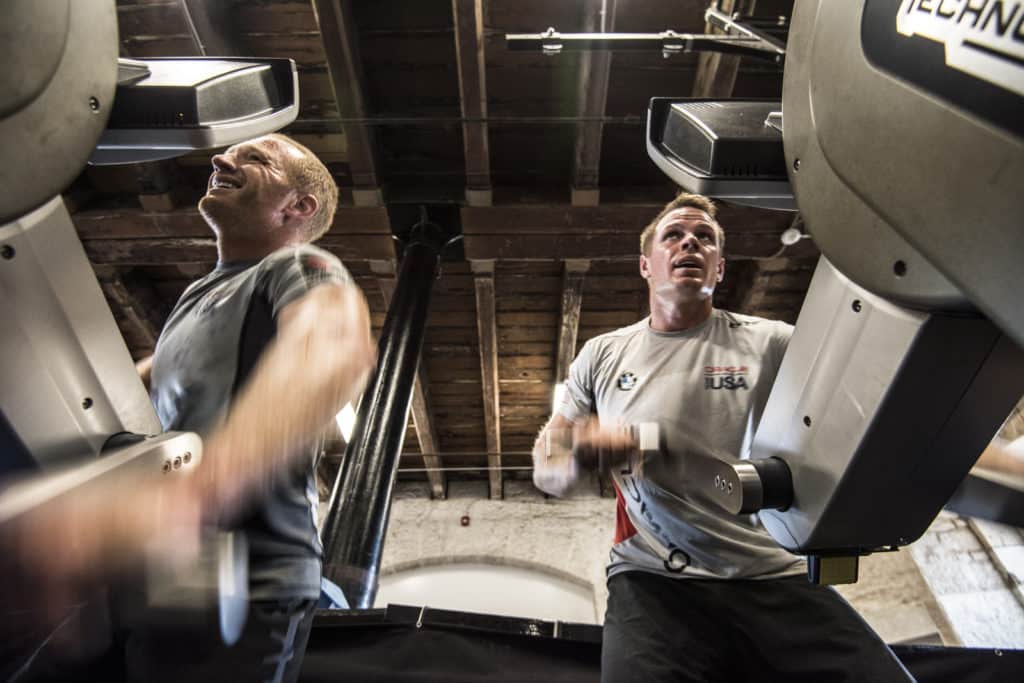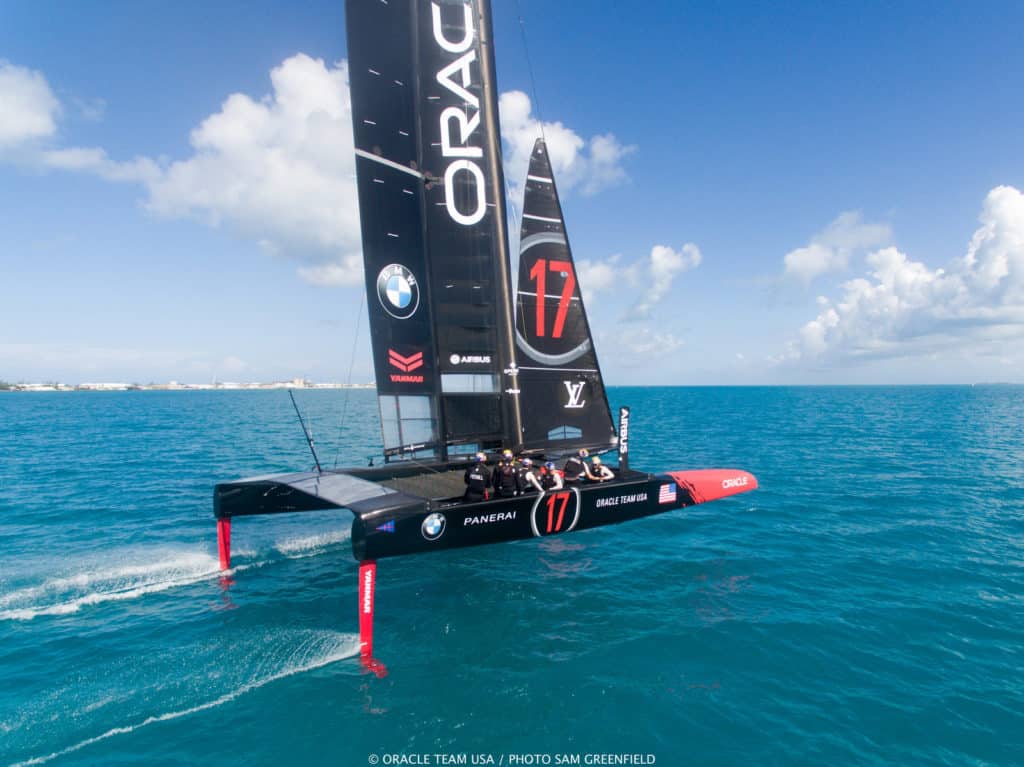
ORACLE TEAM USA training in Bermuda for the 35th America’s Cup
The imagery is iconic: 12-Meter crews waging America’s Cup warfare on the windswept waters off of Fremantle, Western Australia, in 1987. An anxious tension hovers over the crews, crouching in their workstations, studying their sails and anticipating a command from the afterguard. A slight windshift catches the tactician’s eye, and he broadcasts a tack. Eleven bodies furiously execute the maneuver, the boat settles onto its new course, the speedometer struggles to break 8.5 knots, and the crews huddle low again.
Flash-forward 30 years, and the role of an America’s Cup crew has changed as dramatically as the boats themselves. While the transition to wingsail-powered foiling catamarans is obvious, less evident are the demands placed on the sailors by the hydraulic-pressure accumulators that are used to trim the daggerfoils and wing in a delicate high-speed balancing act. The 35th America’s Cup will be the first defense to use stored energy, and the hard-boiled reality is that without accumulator pressure, an AC boat can’t be controlled.
“All of the sailors are going to have to be massively physically capable,” says Giles Scott, a 2016 Olympic gold medalist and the tactician/grinder aboard Land Rover BAR. Scott describes his job as one that involves feeding critical information to skipper Ben Ainslie while spinning the handles on his shared grinding pedestal. Tacticians have always been chess masters, but now they need to think quickly while sustaining a heart rate that would challenge most elite-level athletes.
“It’s a lot more grinding orientated because you need the power to get the boats around the course,” says Rome Kirby with Oracle Team USA, about the AC35’s onboard roles. “I wouldn’t say anyone’s any smarter; it’s the Cup that’s changed.”
Rather, Kirby describes the team’s onboard responsibilities as being similar to those aboard the 72-footer USA 17 that he and his teammates raced to win AC34 on San Francisco Bay, except they now sail their 50-foot America’s Cup class boats with just six sailors instead of 11.
While Kirby explains that OTUSA worked hard to simplify its systems to cope with fewer hands, AC35 will handsomely reward teams that are nimble enough to stay on their foils through jibes and tacks.
All good sailors perform careful dock-out procedures, but ACC boats require far more pampering, especially as control systems are developed and refined. Given the integrated nature of the boat’s systems and electronics, OTUSA divides areas of concern (e.g., electronics, wing controls, foils) over their entire crew, with at least one sailing-team member personally responsible for ensuring that his assigned equipment and systems are properly sorted before each sailing day. The level of attention applied to maintaining and improving USA 17 borders on obsession. It’s either that or dominoes topple.
“We’re religious about checking the boat before pushing-off the dock,” said Kirby, who — along with teammate Cooper Dressler — is responsible for USA 17’s electronics and communication equipment.
“If something doesn’t work, it’s on you to raise a red flag,” says Kirby, emphasizing the responsibility that each crewmember takes in ensuring the boat is ready to fly the moment wind touches the wing.
Once sailing, maintaining accumulator pressure becomes a mission-critical task that’s tackled by four sailors. “Grinding is still a big priority,” says Kirby, explaining that aboard USA 17, the first four sailors (moving bow to stern) primarily grind. This scheme, which is employed by five of the six competing teams, frees the skipper and the wing trimmer to get the boat around the track.

ORACLE TEAM USA training in Bermuda with the new America’s Cup Class boat
Unlike a monohull, where the foredeck is the front line, no one needs to go before the forward beam. “I wouldn’t say anyone has the sketchiest job; all of us have the same [exposure],” says Kirby, who explains that everyone cycles through the boat’s business district. “I’d say the sketchiest point is crossing the boat while you’re tacking or jibing, or in the pre-start — it gets a little sketchy because of the amount of G-forces when the boat [turns] …. There’s a high potential for getting thrown off.”
To cope with these dynamic and potentially dangerous situations, each sailor must be in top form — both physically and mentally — which requires a rigorous training regime, calculated nutrition and a 24/7 commitment to the team’s goal. “I’m the fittest I’ve ever been,” says Kirby, who describes a cross-training routine that’s rich in cardiovascular work, strength training and ample sailing time. While races of yore were cerebral, marathonlike events punctuated by furious-but-short-lived moments of all-out grinding, AC35 races will be 15- to 20-minute sprints with a premium on nonstop power-endurance grinding.
The rules mandate each crew’s combined weight cannot exceed 1,157 pounds, but teams can allocate this weight among themselves. As a result, most skippers and wing trimmers have been surrendering mass to their grinders and trimmers, as evidenced by helmsmen Ben Ainslie, Jimmy Spithill, and Dean Barker, all of whom are noticeably leaner. The corollary, of course, is that the sailors up front have optimized their physiques. Kirby, for example, tipped the scale at 187 pounds during AC34 but has gained 13 pounds for AC35. “I struggle to keep weight on,” he confesses, even with extraordinary calorie consumption.
While Cup sailing has long been a professional sport, current editions have seen it evolve into a seven-day-a-week job. The commitment level treads heavily on personal time and family life. Moreover, while Bermuda is a postcard-perfect island nation, diversions for the sailors are limited.
“I love the island and the people, but I sometimes wish there was a little more going on than spending time on the water,” admits Kirby, who recalls catching post-sailing San Francisco Giants games during AC34. Still, he’s quick to point out that Bermuda encourages constant sailing — with the team and aboard his Moth — and facilitates a blinders-on mentality toward defending the Cup. “We’ve accepted it and buckled down,” says Kirby. “It will be well worth it to hoist the Cup over our heads in June.”
While previous Cups may have been more cerebral, AC35’s acceptance of stored energy has ushered in a new era that demands world-class sailing skills, lightning-quick decision-making, Olympic-caliber VO2 max levels, and the crew choreography to foil through any maneuver.
Here’s a breakdown of Oracle Team USA’s crew duties, from helmsman to forward grinder.
The helmsman flies the boat using her twin wheels and helm-mounted daggerfoil-control systems. He maintains dialogue as needed with the wing trimmer and the tactician to keep the boat fast and tactically engaged.
The wingsail trimmer faces forward and works closely with the helmsman to ensure optimal wing trim and ample boatspeed.
The forward-facing tactician/grinder grinds when he’s not calling tactics or feeding the helmsman with critical, need-it-now data. Additionally, he briefly steers the boat out of maneuvers while the helmsman crosses the trampolines.
The grinder faces the rudders and focuses solely on generating critical hydraulic pressure.
The second grinder aft shares a pedestal with the forward grinder and is also responsible for setting and dropping the daggerfoils and trimming the self-tacking jib.
The forward-most grinder faces astern and delivers dedicated power-endurance grinding.









